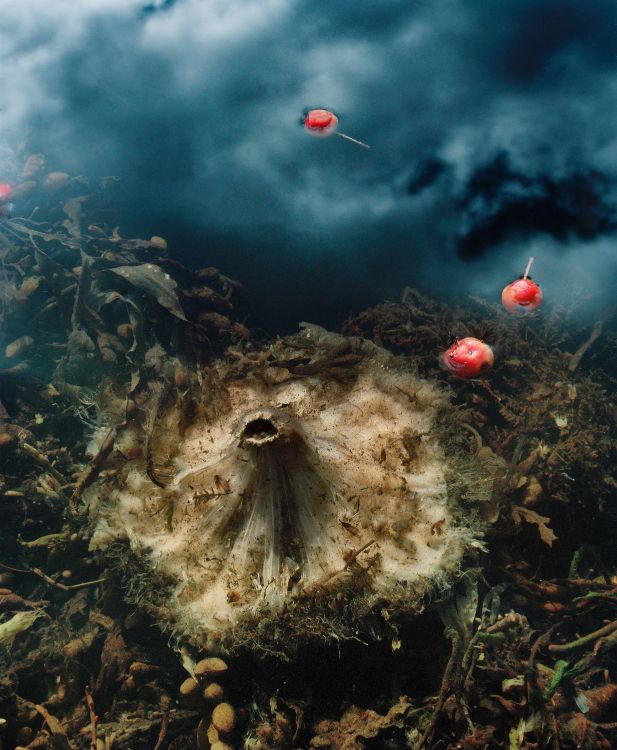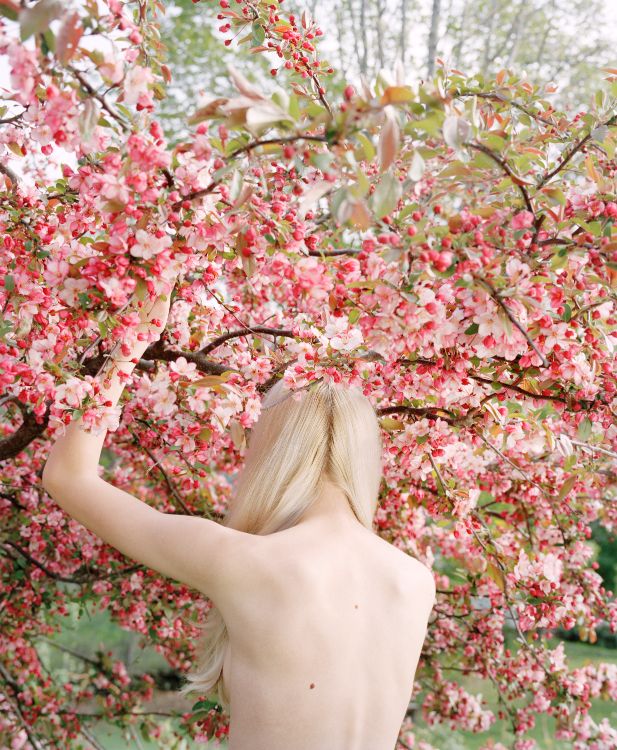Visible and mobile, my body is a thing among things; it’s caught in the fabric of the world, and its cohesion is that of a thing. But, because it moves itself and sees, it holds things in a circle around itself.
Maurice Merleau-Ponty
Throughout her career, Jocelyn Lee’s photographic practice has utilised portraiture as a tool to explore the tactile qualities of the living world. Her richly descriptive colour works emphasise the tonal and textural richness of foliage, fabrics and flesh. Lee’s series The Appearance of Things encompasses several of the classical genres of both photography and painting, as landscape and still-life are eloquently intertwined with portraiture. The images in the series are bound together by Lee’s poetic exploration of the sensual and visceral world.
Lee is driven by existential themes, including those of family, sexuality, ageing and death. Through her works, Lee undertakes a phenomenological exploration of how our bodies are enmeshed in an ever changing, ephemeral world. The philosopher Maurice Merleau-Ponty, for instance, emphasised the body as the primary site of truly knowing the world, and in Lee’s photographs, women’s bodies are submerged in gently lapping water or dappled with the warmth of sunlight in compelling portraits. In The Appearance of Things, these portraits are counterpointed with contemporary memento mori. Rotting flowers and fruit glisten in Lee’s vivid and painterly still lifes. Together, the series reflects on life’s transitions from birth through to death.

Dark Matter #6, The Sunflower’s Belly, 2016. Jocelyn Lee
Lee’s work finds beauty in difficult places, and seeks to explore and expand conventional definitions of female beauty. Her portraits are raw, honest and rich in implied narrative. Portraits included in The Appearance of Things show women both young and old, often situated within the natural landscape. ‘I want to expand the notion of the beautiful to include the more vulnerable stages of life, including adolescence, pregnancy, middle age, old age and illness,’ Lee has said of her work, ‘I am interested in embracing what others may see as physical imperfection or vulnerability, and documenting it with the eyes of a lover.’ In Lee’s photographs, each strand of hair and each freckle on flesh is rendered with immaculate and exquisite detail. The sitters are endowed, therefore, with a vivid and powerful presence.
Lee has spent much of her career mediating on depths of meaning that can be drawn from the photographic portrait. The human body, for Lee, is a site onto which intense physical experiences are explored, of loss as well as love, of fragility and vitality. She is interested in conveying universal truths and unspoken shared experiences through her work, and has said of her portraiture,‘I don’t think I am capturing some truth about these individuals. I think I’m mining emotional states of being that feel familiar to all of us, expressed in the specificity of this one individual in a particular time and place.’
Lee spends great lengths of time with the subjects of her portraits.The intimate exchange of photographer and sitter brings an essential energy that Lee seeks to harness in her compositions. She has stated that she is interested in ‘what happens when two people spend a long time in a room together’, explaining that ‘something changes. Expressions change. Facades drop. Boredom happens, humility happens, other states get revealed.’ She is drawn to particular subjects, and has returned to photograph a select few models again and again. Some subjects have been returned to over the course of over twenty years. Her fascination with both the physical and psychological transitions of life has produced incisive portraits that capture the transition from adolescence to adulthood, as well as the changes that ageing registers on the body.
The nude figure is central in many of Lee’s works. Older bodies, fleshy bodies, bodies that have scars and sagging skin are imbued with the grandeur of classical nudes. ‘Taking our clothes off is a literal and metaphoric state of openness’ Lee has said, ‘it is hard to be naked in front of others. It is hard to be seen naked. It is brave in an essential way. The flaws we imagine are so much more visible when we are naked – and this goes for psychological flaws as well as physical. So nudity is important to me. Nakedness.’ There is indeed a sense of the profound and immutable in Lee’s nude studies. They are monumental in composition and dynamic in the way they react and relate to their settings. Nudity feels inevitable in The Appearance of Things; as our skin, of course, is our primary tool for understanding and connecting with the tactile world that surrounds our bodies.
Lee’s photographs are best understood as evocative, and often revelatory, explorations of what it means to live within a body. Wistful, wondrous and tender, the photographs reflect on the most subtle and overlooked aspects of our own bodies and lived experience. As the poet Sharon Olds notes, ‘Jocelyn Lee welcomes us to contemplate the secrets hidden in plain sight’
(By Thea Gregory)
